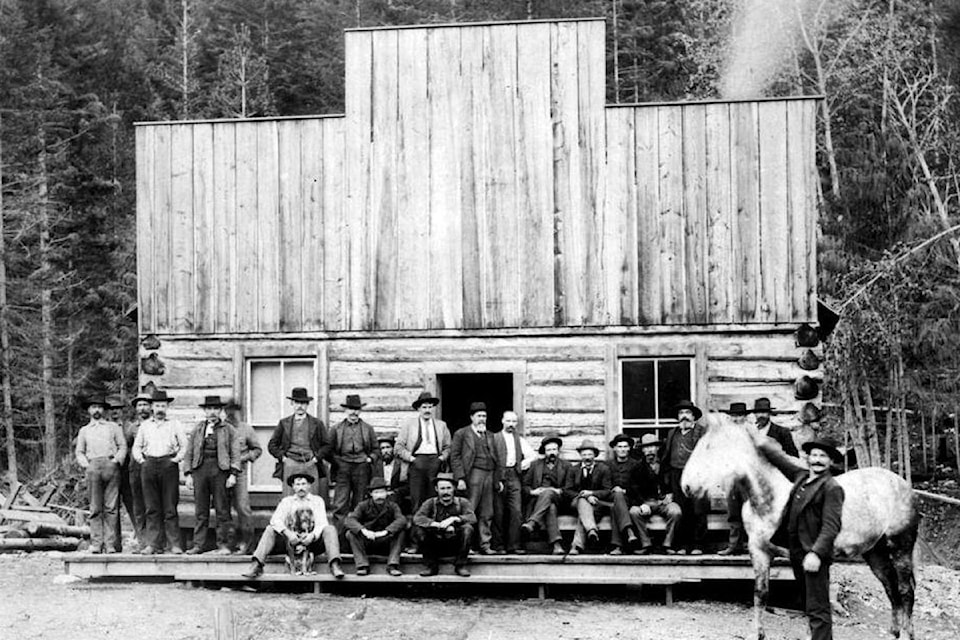Early in the summer of 1892, J.W. Cockle stood atop a sizable rock on Carpenter Creek in the Slocan district. He was shaping a pole. His axe overshot its target, and cleaved off a piece of the rock. He was astonished. It sparkled. It was clearly galena, a silver-lead ore. Cockle and his partner dug around it. It was not a rock. It was a boulder.
The two men sold the boulder, estimated at 125 tons, for $2000. It yielded $20,000 of silver, a staggering sum in 1892. A picture of the boulder and the two men appeared in newspapers across North America, spawning tales of solid silver discoveries in the Slocan district of the Kootenays.
Going back further in time to 1891, it becomes clear how Cockle and many other Kootenay men came to be on Carpenter Creek in the spring and summer of 1892. Ainsworth was the earliest town on Kootenay Lake. It was the site of early silver mines and a base for prospectors.
Two prospectors heard rumours of rich deposits of galena being used by aboriginal hunters, perhaps the Sinixt and/or Ktunaxa peoples. The two men left Ainsworth and tracked into the Slocan wilderness in search of silver. Eli Carpenter was a French Canadian, and Jack Seaton was from Tennessee.
Veronika Pellowski, in Silver, Lead and Hell, wrote that they had no success. Two months on, they climbed Payne Mountain to locate a route back to Ainsworth. (The mountain towered high above the future location of Sandon.) The date, September 19, 1891. Pellowski wrote, “There they accidently discovered an outcrop of high grade galena.” Intrigue still surrounds the discovery, 133 years later.
Legend says Carpenter told Seaton the ore assayed at 20 ounces to the ton. In fact, it assayed at 170. Carpenter revealed the deception to his new partner in the Ainsworth saloon. The saloon owner overheard, and informed Seaton. But legend may not match facts. Carpenter and Seaton recorded their claim in Ainsworth a few days after the find. Would Seaton record a claim he believed mediocre?
In any case, the two men, returned to the mountain by different routes. Seaton had formed a new partnership with a group of four men. They reached the Payne claim before Carpenter, and proceeded along the ridge searching for galena. They staked the “Noble Five” group of claims, 21 in total! Incredibly, all 21 came to be actively mined.
‚ÄúWILD OVER A NEW DISCOVERY,‚Äù a newspaper headline enthused. ‚ÄúThe reports circulated and stories told by Jack Seaton, the Hennessy boys, Frank Flint, and John McGuygan on their return from the Kaslo-Slocan divide, on Thursday, set the town of Ainsworth wild with excitement. ‚Ķ [The five men] discovered a ledge that made every one of the party imagine himself at once a millionaire ‚Äì and they are still pretty strong in that belief.‚Äù (Hot Spring —«÷ÞÃÏÃ√. Ainsworth, B.C., October 3, 1891.)
The word quickly got around. Hundreds of prospectors arrived in the Slocan in the fall of 1891. “Ainsworth Camp was left virtually deserted for days,” the Sandon Historical Society (SHS) wrote. Over 190 claims were staked before the year ended. One of these was the fabulously rich Slocan Star discovered by Bruce White, John Chambers and John Sandon, for whom the town was named.
Alas, Seaton and his partners never got rich. They sold off the mines very early, far below their real worth. Spokane mining interests arrived quickly in the Slocan, by November 21. S.S. Bailey, alone, purchased four mines. He bought Seaton’s half interest in the Payne too, for a meager $500. The mine went on to produce over one million ounces of silver-lead per year.
In the spring of 1892, prospectors continued to enter the Slocan, J.W. Cockle among them. Once the photo of the galena boulder had been widely published, “a tidal wave of men, including thousands of Americans, began to flood into the Slocan district,” wrote the SHS. The galena boulder augmented the influx of miners, but Slocan towns would take time to develop.
John Morgan Harris, soon to be the richest man in the Slocan, arrived in 1892 as well. Rudimentary cabins and stores were present in Sandon, but development was disorderly. Harris shrewdly staked a claim on the valley floor, and advised the “squatters” to move their buildings or pay for the land they sat upon. He profited well and invested heavily over time in his own businesses and in nearby mines.
Businessman Robert E. Lemon laid out the first townsite in July of 1893. Harris then added to it. He laid out Reco Street and the business district, and began to sell lots. Orderly development was now assured. The population was growing, and merchants were arriving. The best days were yet to come!
Next week, Part 2, The boom years in Sandon.
A column by Bruce Uzelman
Bruce Uzelman, based in Kelowna, holds interests in British Columbia history as wells as current political and economic issues.
Bruce had a career in small business, primarily restaurant and retail. He holds a Bachelor of Arts, Advanced from the University of Saskatchewan, with Majors in Political Science and Economics.
Contact: urban.general@outlook.com


